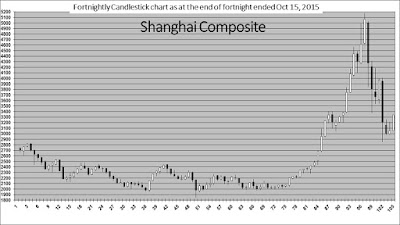USDEUR and USDINR
With the conclusion of the recent
FOMC meeting and release of its policy decisions on October 28th at
2:00 p.m. US time, which coincides with 11:30 p.m. IST, the USD immediately
became volatile and strong against EUR and the strength of USD also reflected against
the INR the following day. Such sudden and knee jerk reactions are normally precursors
and a confirmatory signal to the change of trends. The knee jerk reactions are a
sign of reversal of positions by punters and market makers who have large exposures
and who try to reverse their positions in the minimum possible time, thereby
acting as front runners of the reversal process. In the usual course, the trend
after such policy meetings is felt reasonably between a few days to a week subsequent
to the policy decision, by which time the punters and market makers would have reversed
their positions.
Post FOMC meeting, which concluded on
October 28, 2015, I have been receiving messages with a lot of scepticism about
my previous posts related to USD wherein I had mentioned that USD is expected
to go weak against currencies of significance and wherein I had specifically presented
charts of USDEUR and USDINR.
To worsen the matter, there are
reports on internet, which speak about the near 2% yield on 10 year US
treasury, etc. which will keep USD strong. Another report speaks that the
Chinese economy is loosening and the devaluation of Yuan will not let USD go weak.
Yet another report speaks of the obsolete Phillips curve. I get confused. If I
do some more search I will perhaps get some more economic parameters and reasons
which will convince the readers that the USD will go stronger. I will further
get more confused.
In nutshell, if you combine all these
factors mentioned above, you will get something called ‘khichri’, a famous
Indian dish offered to sick people suffering from loose motions.
A very dear friend went to the extent
of saying, “You are stubborn.”
BUT I AM NEITHER STUBBORN NOR CONVINCED.
Of all the derivatives – commodities,
indices and currencies – currencies are the slowest to move. Such a slow
movement may cause a range of variations in the opinions of people having interest
in predicting currencies either because of exposures or because of profession and
at times it is really hard to determine the precise time of change in the trend.
With the objective of substantiating
my view, I am presenting a few charts again to clarify or rather magnify my
point of view.
USDEUR
The multi-period candlestick chart of
USDEUR has made multiple reversal candles and although the close of the last
candle has been higher than the close of the previous candle, the entire last candle
is formed within the range of the previous candle. This is coupled with a confirmed
squeeze about to be completed on the line chart/ graph with adapted Bollinger
Bands. This typical squeeze is more of a bearish squeeze rather than a bullish
squeeze.
USDINR
The line graphs of Silver and USD
with appropriate moving averages for their movement cycle/ momentum and with suitably
adapted Bollinger Bands are compared in the following charts. The time periods
of the line charts are mentioned thereon. The third chart is the extension of the second line chart.
The middle, upper and lower bands of
the USDINR chart have flattened and are now in the early stage of narrowing
down, causing to initiate the formation of a squeeze. It is quite possible that
the actual USDINR rates continue to remain towards the upper end of the upper band but
the process of formation of squeeze will lead the USD to drift lower. This may
be gradual or abrupt. It is anybody’s guess.
Best wishes for the festive season.
For any clarifications please feel
free to contact.
Disclaimer:
These extracts from my trading books are for educational purposes only. Any advice contained therein is provided for the general information of readers and does not have regard to any particular person's investment objectives, financial situation or needs and must not be construed as advice to buy, sell, hold or otherwise deal with any commodities, currencies, securities or other investments. Accordingly, no reader should act on the basis of any information contained therein without first having consulted a suitably qualified financial advisor.

















